Add-Ons
Kinsta offers a number of add-ons to help you get the most out of your WordPress site. You can view and manage all of your add-ons from within MyKinsta > WordPress sites > sitename > Add-ons.
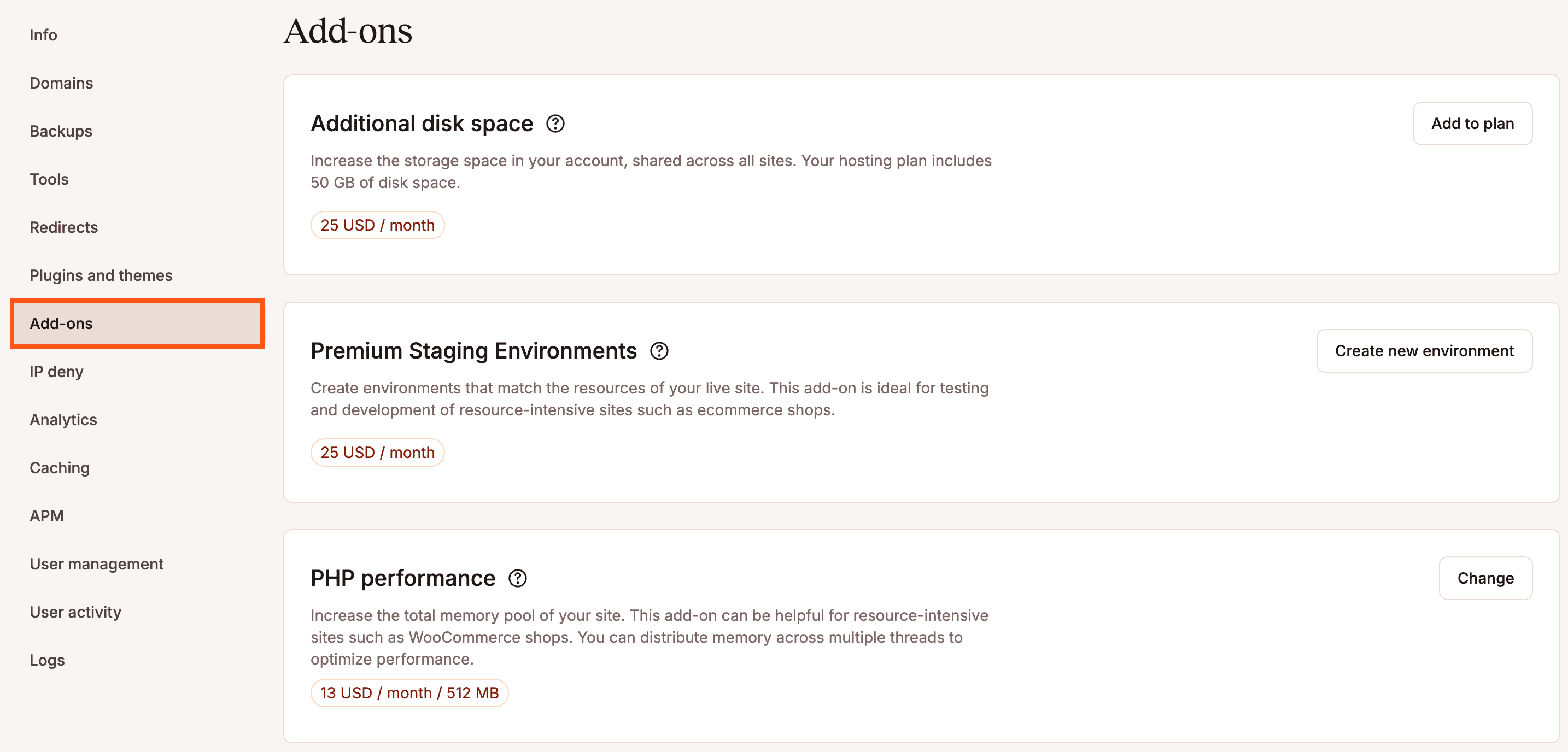
Disk space add-on
Some WordPress sites, by necessity, are a bit “heavy,” meaning they contain a lot of large files. In some industries, photography, for example, you may need to host high-resolution photos. While you can offload these to a file storage service like Google Cloud or Amazon S3, this isn’t always easy or convenient.
Another common pain point we see for agencies and developers is that you may only have one or two clients that need most of your plan’s disk space.
All hosting plans at Kinsta include a set amount of SSD disk space, you can check your total disk space usage on the Resource usage chart on the Dashboard in MyKinsta. If you exceed your plan’s disk space allocation, we charge an overage fee. With our disk space add-on, you can increase your hosting plan’s storage space without upgrading your plan or incurring overage fees.
To add the disk space add-on, within Add-ons, under Disk space, click Enable. The disk space add-on can be purchased in 20 GB increments at $20/month per hosting plan. You can purchase as many of these add-ons as you want. Choose how much additional disk space you would like to add, and click Continue.
You can also add the disk space add-on by going to your username > Company settings > My Plan, and within Disk space, click Enable.
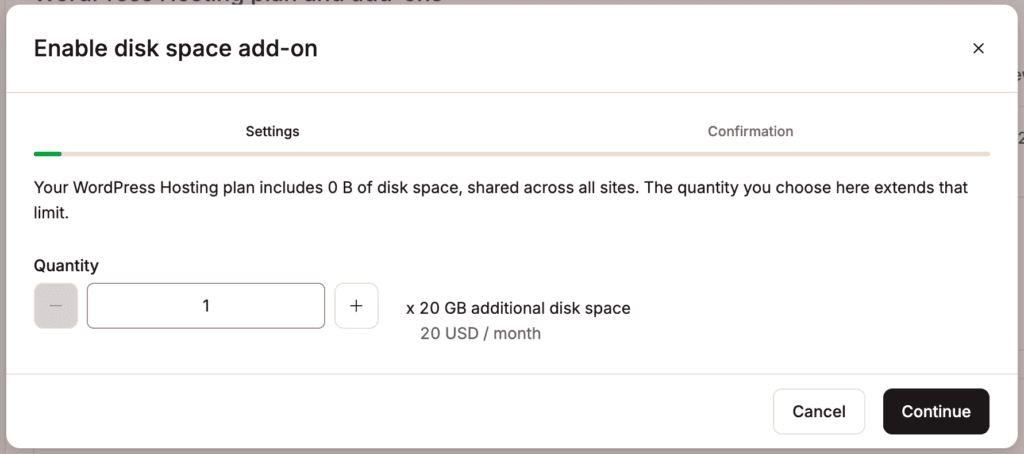
For example, if you’re on the WP 5 plan at $115/month and purchase one disk space add-on, your monthly bill would be $135/month. The plan already comes with 30 GB, so you would then have a total of 50 GB of available disk space. If you purchase two add-ons, your bill would be $155/month, with a total of 70 GB of available disk space.
Disk space add-ons are automatically prorated, and the subscription will appear on your next billing cycle.
Change the Disk space add-on
To modify the disk space add-on, navigate to WordPress sites > sitename > Add-ons, and under the Disk space section, click Change. You can modify the number of add-ons or remove the add-on altogether by reducing the quantity to zero, then click Continue.
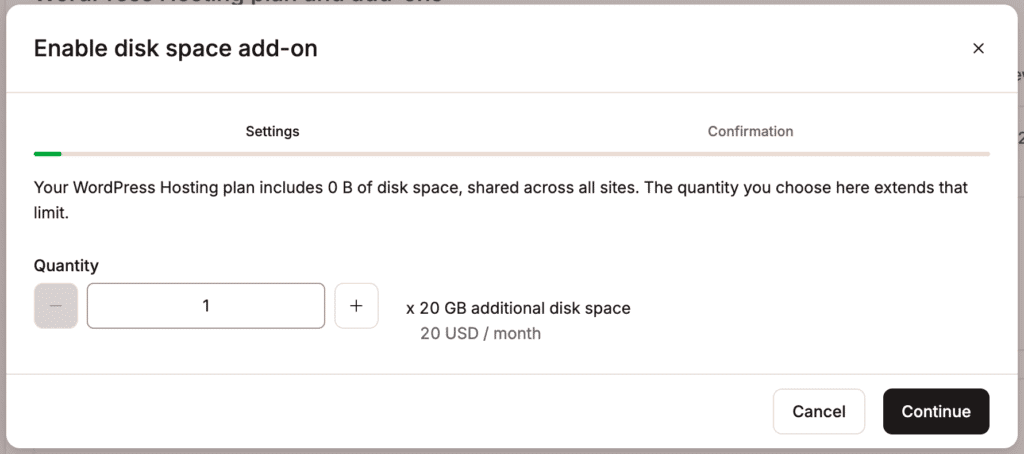
Remove the disk space add-on
To remove the disk space add-on, within Add-ons, under Disk space, click Disable > Disable.

Any actions related to adding, removing, or changing the disk space add-on are recorded in the MyKinsta Activity Log.
If you remove the disk space add-on and you’re in the first 30 days of your WordPress Hosting plan, a prorated fee for the add-on will be added to your next invoice for the time period it was enabled. If your WordPress Hosting plan has been active for more than 30 days, you will receive a prorated credit for the add-on fees to your Account Balance for the remaining days of the current billing period. The credit is automatically used to offset money owed to Kinsta on your next invoice. For more information, refer to our WordPress Hosting Money-Back Guarantee.
Premium staging environments add-on
If you want to add additional staging environments, need a staging environment that more closely matches your live environment, or need to do resource-intensive site testing or development, you can purchase a Premium Staging Environment add-on.
You can add up to five Premium Staging Environments to each WordPress site. While a Standard Staging Environment will still work for most testing, using a Premium Staging Environment is ideal for resource-intensive site testing or development.
Each Premium Staging Environment has 12 CPUs, 8 GB of Memory, and the same number of PHP threads you have for your live site (based on your plan). You can also turn on Kinsta CDN for a Premium Staging Environment. With a testing environment that closely matches your live environment, you can also perform website speed tests on your test site.
The Premium Staging Environment add-on can be purchased for $20/month per site (prorated). You can purchase up to 5 premium staging add-ons per site. Each Premium Staging Environment add-on is automatically prorated, and the subscription will appear on your next billing cycle. Including the free Standard Staging Environment, this allows you to have a total of 6 environments for testing and development that are completely separate from your live site.
To add a premium staging environment, within Add-ons, under Premium Staging Environments, click Create new environment and follow the steps to Create WordPress Standard or Premium Staging Environment.
Remove the Premium staging environments add-on
To remove a premium staging environment add-on, you must delete the staging environment.
If you remove the premium staging environment add-on and you’re in the first 30 days of your WordPress Hosting plan, a prorated fee for the add-on will be added to your next invoice for the time period it was enabled. If your WordPress Hosting plan has been active for more than 30 days, you will receive a prorated credit for the add-on fees to your Account Balance for the remaining days of the current billing period. The credit is automatically used to offset money owed to Kinsta on your next invoice. For more information, refer to our WordPress Hosting Money-Back Guarantee.
PHP performance add-on
The PHP performance add-on allows you to increase your total PHP memory pool, the number of PHP threads, and the PHP memory limit. You can also view and change your PHP performance within WordPress sites > sitename > Info > PHP performance.
The PHP performance add-on costs $10 per additional 500MB per month. For example, if the total PHP memory pool in your plan is 1.5GB and you want to increase it to 3GB for a site, this is an increase of 1.5GB, and therefore, you will be charged $30 per month for the add-on.
To purchase this add-on, click Change on the Add-ons page under PHP performance.
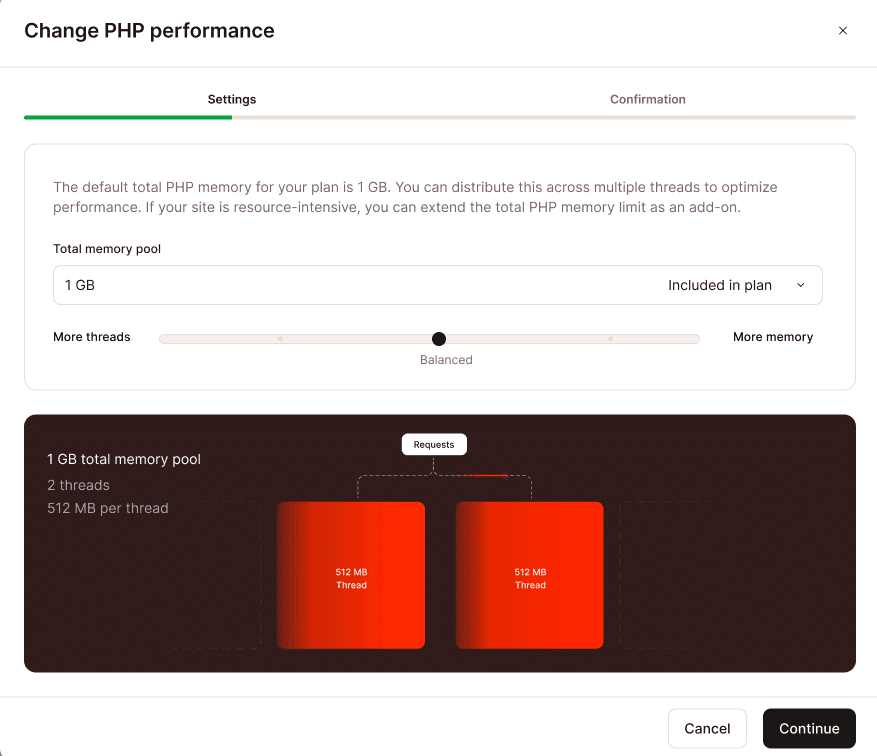
This shows your Total memory pool in your current plan. The memory pool is the total PHP memory distributed across your PHP threads. For example, if you have 4 PHP threads and a total memory pool of 2GB, the PHP memory limit for each PHP thread would be 512MB.
You can adjust the Total memory pool to allocate more memory across PHP threads. However, the maximum limit depends on your plan:
- Standard plans with a default memory pool of 4GB or more cannot be increased further.
- Custom plans with a default pool up to 2GB can be increased to a maximum of 4GB.
- Custom plans with a default pool above 2GB can be increased to a maximum of 8GB.
You can use the slider to add:
- More threads: You can move the slider towards this to increase the number of PHP threads for your site. When you increase the number of threads, the PHP memory is automatically distributed across the higher number of threads, this may mean you have less memory per thread. For example, if you have 16 threads with a total memory pool of 2 GB, the PHP memory limit for each thread is 128MB. If you increase the threads to 32 but keep the memory pool the same, the PHP memory limit for each thread will be 64MB.
Note: If you use WooCommerce, you should ensure the memory per thread is at least 128 MB. If it is lower than this, your site may experience downtime and errors.
More threads allow your site to handle multiple incoming requests simultaneously. However, with less memory per thread, memory-intensive tasks like large database queries or media uploads may exceed the available memory, leading to errors. This is important to consider when configuring your site.
Dynamic sites that generate content in real-time, such as e-commerce platforms, CMS-driven websites, or forums, are more likely to benefit from having more threads. Static sites that display fixed content, such as blogs, documentation, or brochure-style websites, generally don’t benefit from additional PHP threads, as their content rarely changes and requires minimal server processing.
You can reduce thread usage by enabling caching and optimizing your code. For more details on minimizing thread usage, refer to Reduce and optimize PHP thread usage. - More memory: You can move the slider towards this to increase the PHP memory limit per thread; however, if you don’t increase the PHP memory pool, the number of PHP threads available will be reduced. The maximum memory limit per thread is 1024MB. For example, if you have 16 threads with a total memory pool of 2 GB, the PHP memory limit for each thread is 128MB. If you increase the memory limit but keep the memory pool the same, this reduces the PHP threads to 2, and the PHP memory limit per thread will be 1024MB.
More memory allows your site to handle more memory-intensive tasks. However, if you have fewer threads this reduces the number of incoming requests your site can handle simultaneously.
As you change the values, the image below the slider shows the updated values and how they are distributed between the threads and memory.
When you’re happy with the thread and memory allocation, click Continue. If you have increased the memory pool, this creates a PHP performance add-on; the price details are shown on the next screen. The subscription will appear on your next billing cycle and is automatically prorated for your current billing period.
Note: Since this add-on is prorated, you can temporarily increase the total memory pool, threads, or memory if you’re anticipating high traffic for events like Black Friday or Cyber Monday. After the event, you can revert to the original settings, and you’ll only be charged for the days the add-on was active.
If you reduce the memory pool to remove the PHP performance add-on and you’re in the first 30 days of your WordPress Hosting plan, a prorated fee for the add-on will be added to your next invoice for the time period it was enabled. If your WordPress Hosting plan has been active for more than 30 days, you will receive a prorated credit for the add-on fees to your Account Balance for the remaining days of the current billing period. The credit is automatically used to offset money owed to Kinsta on your next invoice. For more information, refer to our WordPress Hosting Money-Back Guarantee.
Pool, threads, and memory distribution values
The tables below show the distribution options available for the memory and threads based on the value of the total memory pool:
512MB memory pool
| PHP threads | Memory per thread |
|---|---|
| 2 | 256MB |
| 4 | 128MB |
| 8 | 64MB |
1GB memory pool
| PHP threads | Memory per thread |
|---|---|
| 2 | 512MB |
| 4 | 256MB |
| 8 | 128MB |
| 16 | 64MB |
1.5GB memory pool
| PHP threads | Memory per thread |
|---|---|
| 3 | 512MB |
| 6 | 256MB |
| 12 | 128MB |
| 24 | 64MB |
2GB memory pool
| PHP threads | Memory per thread |
|---|---|
| 2 | 1024MB |
| 4 | 512MB |
| 8 | 256MB |
| 16 | 128MB |
| 32 | 64MB |
2.5GB memory pool
| PHP threads | Memory per thread |
|---|---|
| 2 | 1024MB |
| 5 | 512MB |
| 10 | 256MB |
| 20 | 128MB |
3GB memory pool
| PHP threads | Memory per thread |
|---|---|
| 3 | 1024MB |
| 6 | 512MB |
| 12 | 256MB |
| 24 | 128MB |
3.5GB memory pool
| PHP threads | Memory per thread |
|---|---|
| 7 | 512MB |
| 14 | 256MB |
| 28 | 128MB |
4GB memory pool
| PHP threads | Memory per thread |
|---|---|
| 2 | 2048MB |
| 4 | 1024MB |
| 8 | 512MB |
| 16 | 256MB |
| 32 | 128MB |
5GB memory pool
| PHP threads | Memory per thread |
|---|---|
| 5 | 1024MB |
| 10 | 512MB |
| 20 | 256MB |
6GB memory pool
| PHP threads | Memory per thread |
|---|---|
| 6 | 1024MB |
| 12 | 512MB |
| 24 | 256MB |
7GB memory pool
| PHP threads | Memory per thread |
|---|---|
| 7 | 1024MB |
| 14 | 512MB |
| 28 | 256MB |
8GB memory pool
| PHP threads | Memory per thread |
|---|---|
| 8 | 1024MB |
| 16 | 512MB |
| 32 | 256MB |
If you require more PHP threads or a higher memory limit per thread, we recommend using a dedicated server.
Remove the PHP performance add-on
To remove the PHP performance add-on from all sites, go to your username > Company settings > My Plan, and click Remove within PHP performance.

This resets all of the sites back to the original PHP memory and threads included in your plan. The confirmation window shows which sites the add-on will be removed from and what the memory pool will be reset to. To confirm the removal, click Remove PHP performance add-on.
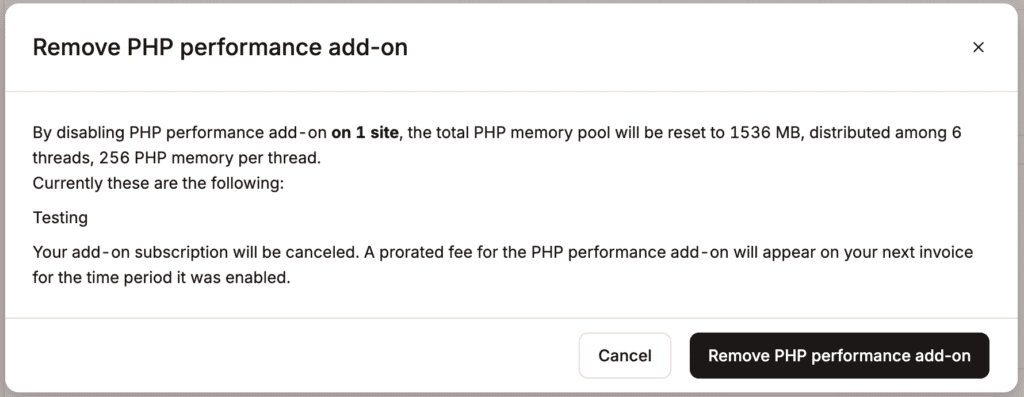
To remove the PHP performance add-on for an individual site, you can change the PHP performance and reduce the Total memory pool to the default value included in your plan. You can also remove the add-on for all sites that have it enabled within your username > Company settings and on the PHP performance section, click Remove.

The confirmation window shows which sites the add-on will be removed from and what the PHP memory pool, thread count, and memory per thread will be reset to. To confirm the removal, click Remove PHP performance add-on.
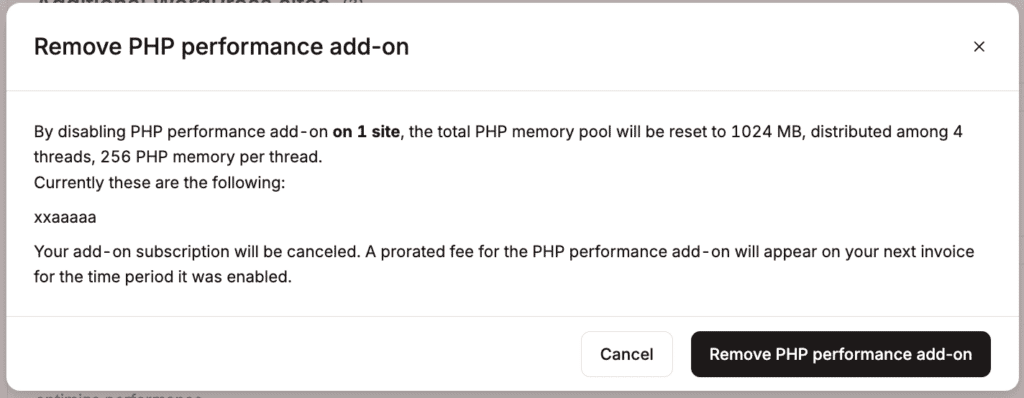
If you’re in the first 30 days of your WordPress Hosting plan, a prorated fee for the add-on will be added to your next invoice for the time period it was enabled. If your WordPress Hosting plan has been active for more than 30 days, you will receive a prorated credit for the add-on fees to your Account Balance for the remaining days of the current billing period. The credit is automatically used to offset money owed to Kinsta on your next invoice. For more information, refer to our WordPress Hosting Money-Back Guarantee.
Kinsta Automatic Updates
With Kinsta, you can enable auto-updates for your plugins and themes for each individual site with either:
- WordPress auto-updates: WordPress automatically installs plugin and theme updates twice daily. It does not run a regression test, so it cannot identify whether an updated plugin or theme causes issues.
- Kinsta Automatic Updates: Kinsta provides automatic daily updates for plugins and themes, which is free for the first month and just $3 per environment per month thereafter. Note: The first month of Kinsta Automatic Updates is free for all plans. If you’re on a Single 35k visits, Single 20GB bandwidth, or WP2 plan, you also get your first month of hosting free. These free periods run separately, meaning if you enable Kinsta Automatic Updates on day 15 of your plan, you’ll still receive a full month of free updates.
All plugins and themes are updated for your site even if they are inactive, and any newly installed plugin or theme is seamlessly added to Kinsta’s Automatic Updates, ensuring you stay protected against vulnerabilities without any extra effort.
Kinsta also conducts a visual regression test on your site to detect significant changes before and after updates. By default, this test compares your homepage and four randomly selected pages from your sitemap. However, you can manually specify which pages to test. If you choose specific URLs, only those pages will be tested, even if fewer than five are provided. This helps detect any significant differences caused by the update. If an issue is identified, Kinsta automatically restores a backup taken prior to each update, ensuring your site remains stable and secure. These backups are available for three days within Backups > System-generated, with a note specifying which plugin was updated when the backup was taken.
Kinsta uses ScreenshotOne to capture and compare screenshots before and after the update. These screenshots, along with images highlighting any differences, are securely stored for 60 days. If your domain has strict security rules that block requests from unknown origins, you may need to configure an allowlist to enable these screenshots. You have two options to achieve this:- Set up a rule that permits requests containing the
User-Agent:kinsta-botheader. - Allow traffic from ScreenshotOne IP address ranges.
- Set up a rule that permits requests containing the
To enable automatic updates, click Change. You can also enable automatic updates within WordPress sites > sitename > Plugins and themes > Automatic updates > Change.
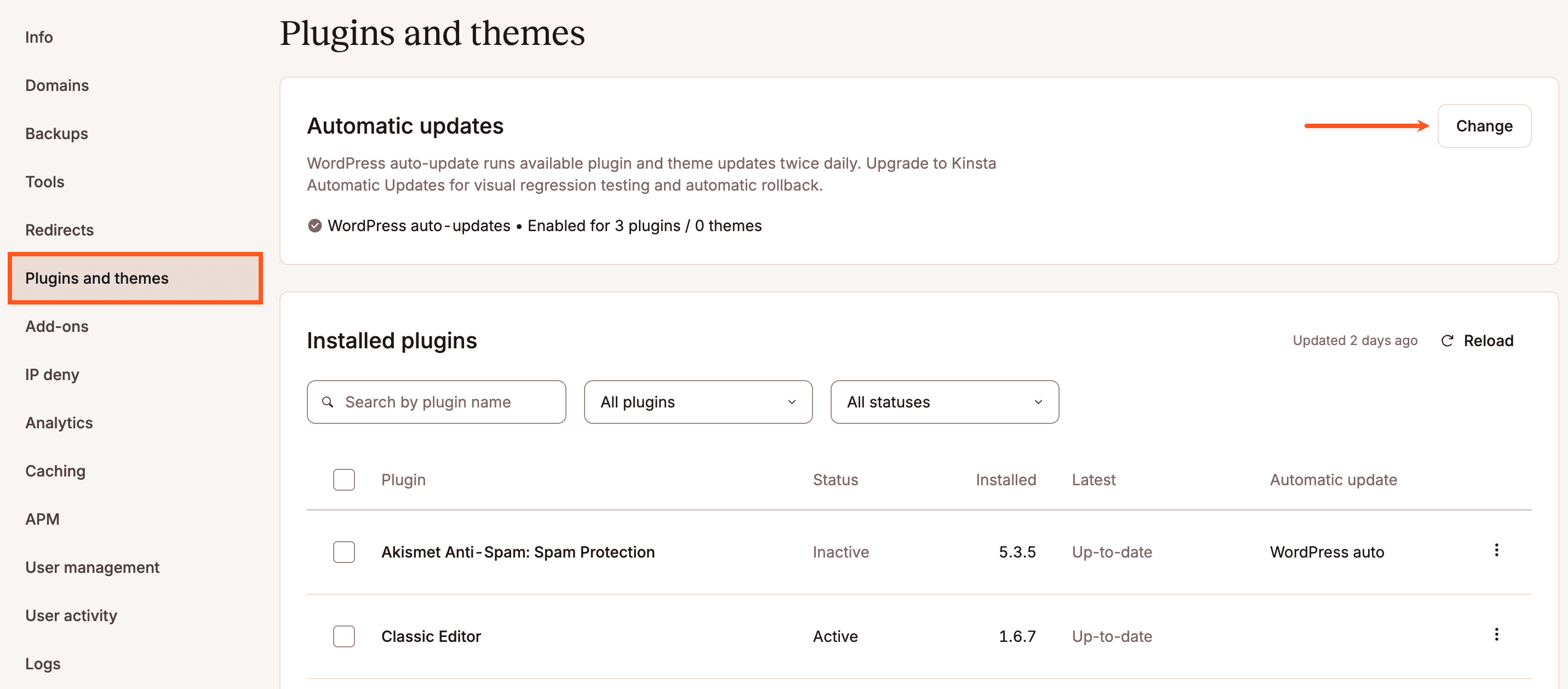
You can also enable auto-updates for your plugins and themes for multiple sites including staging sites, simultaneously from the WordPress Sites page. Select the checkboxes next to the sites you want to enable auto-updates for, click Actions, and choose Change automatic updates.
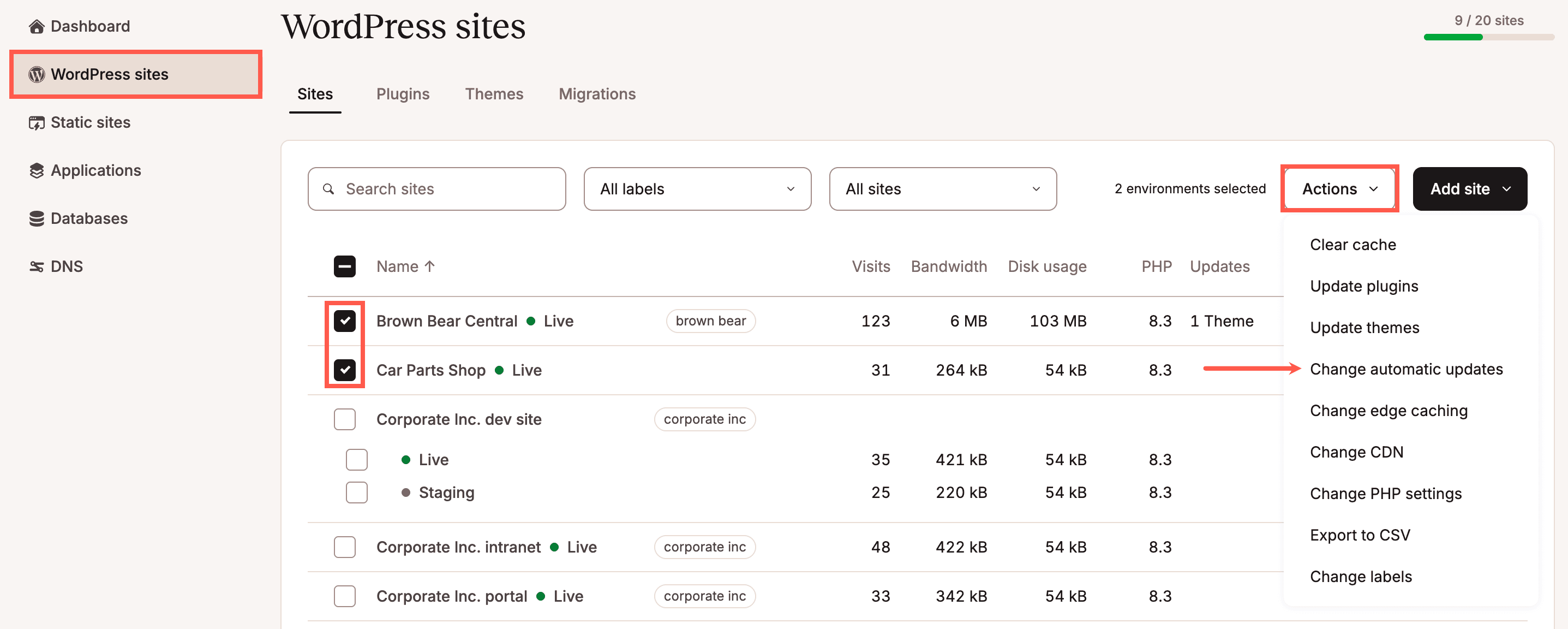
Select WordPress auto-updates and click Change automatic updates, or select Kinsta Automatic Updates and click Continue.
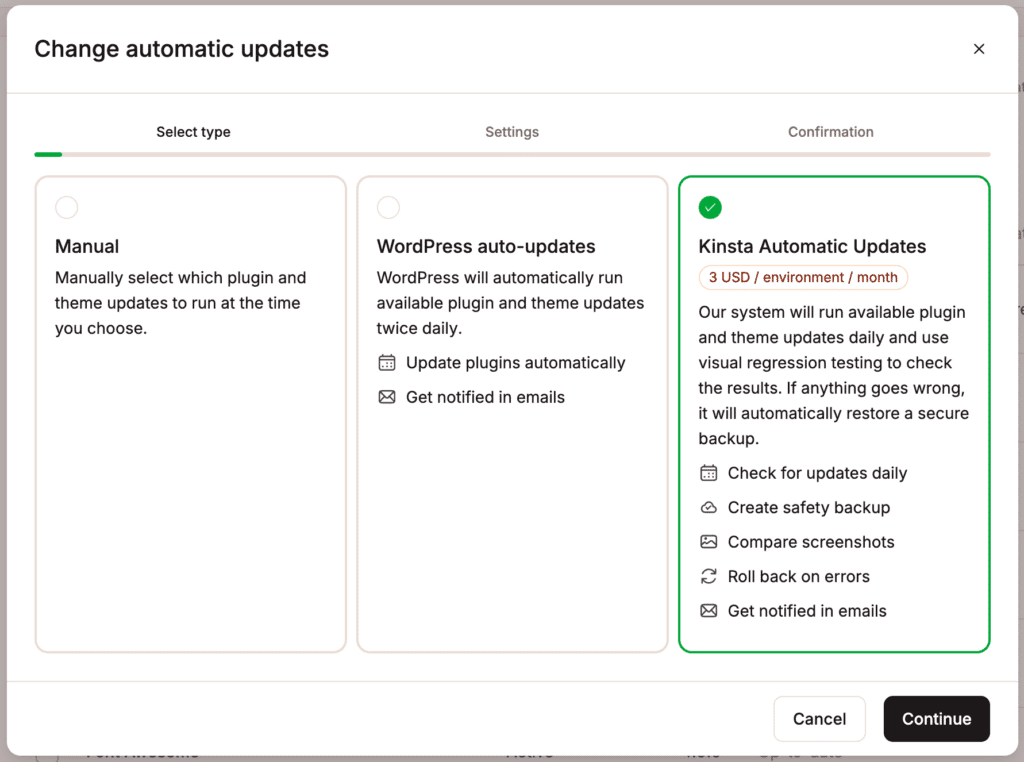
If you select Kinsta Automatic Updates, you can define the automatic update settings. You can change any of these options at any time within Settings.
Settings
If you want to change any of the settings for Kinsta’s automatic updates after enabling them, click Settings.

Testing frequency
Select the days you want the updates to occur on your site. For example, if you only want updates to occur on weekends, select Saturday and Sunday only.
Testing time window
This is when you want the updates to occur on your site.
Test URLs
Kinsta’s automatic updates feature compares your homepage and four randomly selected pages from your sitemap by default. If you’d prefer to test specific pages instead, you can define up to five custom URLs in the Test URLs field. Enter each URL on a new line. Only the URLs you specify will be tested, even if you provide fewer than five.
During the update process, Kinsta will compare images of each specified page before and after the update. The Sensitivity setting controls how strictly changes are detected.
If no URLs are specified, Kinsta will default to testing your homepage and four randomly selected sitemap pages.
Enable WordPress maintenance mode
Select this option to display a maintenance page when the updates are running. The maintenance page only appears while the updates are running and not for the entire duration of the Time window.
Dynamic content
If you want to change any of these settings after enabling Kinsta automatic updates, click Settings.
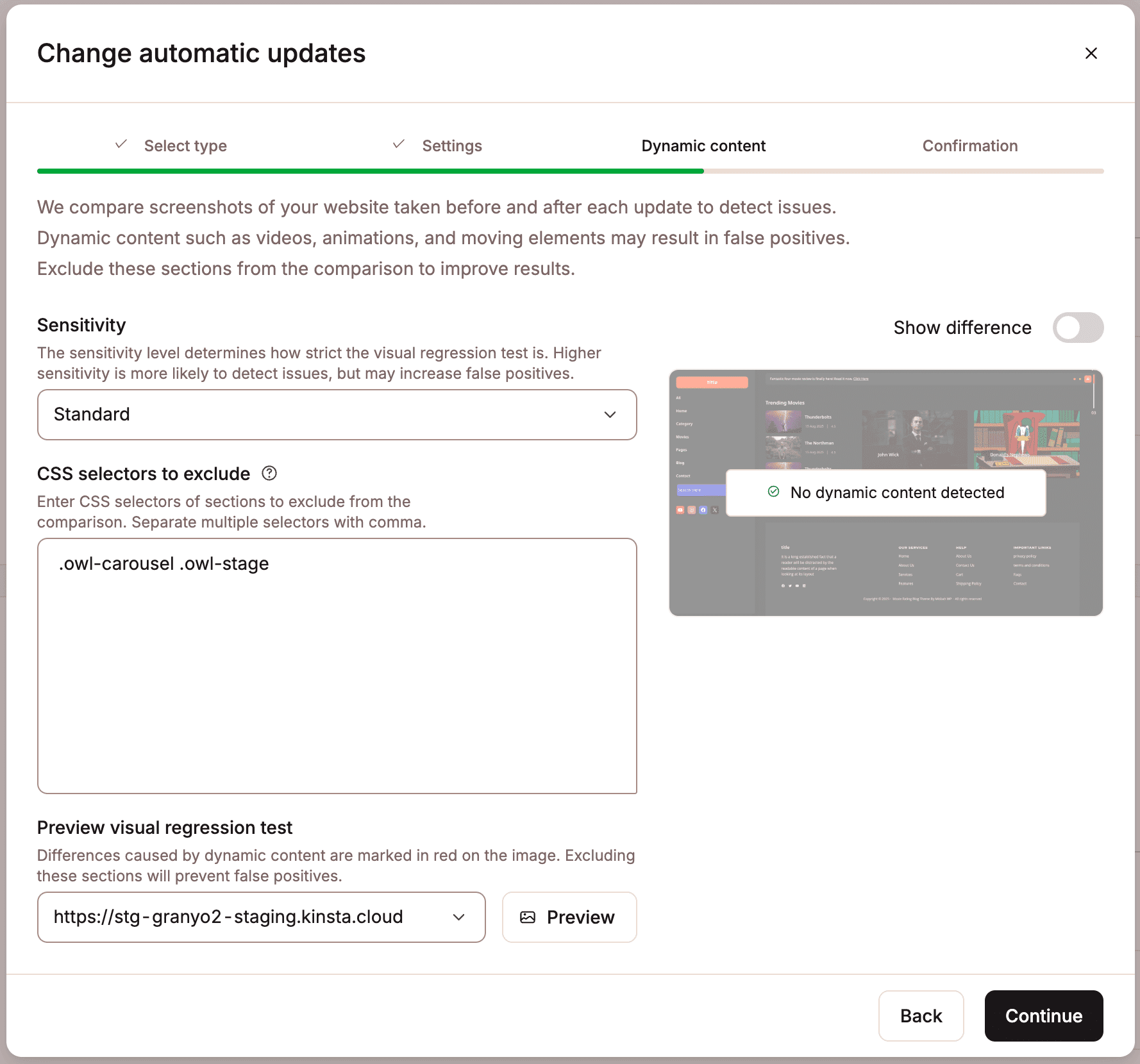
Some websites include dynamic content, which changes automatically or depending on who’s visiting the site. This could be things like:
- A rotating banner or slider
- A “Welcome back!” message
- A live feed or chat widget
When MyKinsta runs automatic plugin or theme updates, it performs a visual comparison of your site before and after the update to detect any unexpected changes. However, if your site includes dynamic content (such as rotating banners, time-sensitive data, or user-generated elements), these visual differences may appear even when nothing is actually broken. In such cases, the update may be incorrectly marked as failed.
This tab scans the page selected in the Preview visual regression test to detect any dynamic content. The pages available for preview are those you previously defined under Test URLs.
We recommend reviewing each page before continuing with the automatic updates setup:
- If no dynamic content is found, you can proceed safely.
- If dynamic content is detected, click Show difference to locate where it appears on the page.
You can then:
- Identify the CSS selectors for the dynamic elements.
- Add these selectors to the CSS selectors to exclude to hide those areas from the visual regression test.
- Optionally, adjust the Sensitivity level.
After making your adjustments, re-run the Preview visual regression test to confirm no dynamic content remains. Once the test passes, you can continue setting up automatic updates.
Sensitivity
This controls how strict the visual regression test is. This test compares each pixel in two images based on color and brightness, with the sensitivity setting determining the threshold for acceptable differences. It uses images of the homepage plus four random pages or images from the Test URLs if defined.
Lower sensitivity allows minor differences to be ignored, while higher sensitivity is more likely to detect even subtle changes but may also increase the chances of false positives.
CSS selectors to exclude
CSS selectors are used in stylesheets to target and apply styles to specific elements within your web pages. By defining the CSS selectors in CSS selectors to exclude, you are simply pointing to specific parts of your website (like a banner or a widget) that you want the automatic updates to ignore.
For example, if your homepage features a banner that changes images regularly, you may want to exclude it from checks. A CSS selector for that banner might be .banner-slider, or a specific ID, such as #daily-message. If you enter this within CSS selectors to exclude, the automatic updates will ignore anything inside the element with the class banner-slider or the ID daily-message. You can use the Preview visual regression test to automatically identify any dynamic content on your pages.
How to find a CSS selector
- Open your site in Google Chrome (or any browser with developer tools).
- Right-click the part of the page you want to ignore and click Inspect.
- In the panel that opens, look for a class (starts with .) or ID (starts with #) for that element.
- Copy that class or ID and paste it into the Hide selectors field in MyKinsta.
Each selector should be on a new line and separated with a comma, for example:

Preview visual regression test
This option helps you identify whether any of your site’s pages contain dynamic content that has not already been excluded. You can check the pages for the URLs you’ve previously defined under Test URLs. We recommend reviewing each page individually to check for dynamic elements. To do this, select the page you want to inspect and click Preview.
If dynamic content is identified on the selected page, a Dynamic content found warning appears as follows:
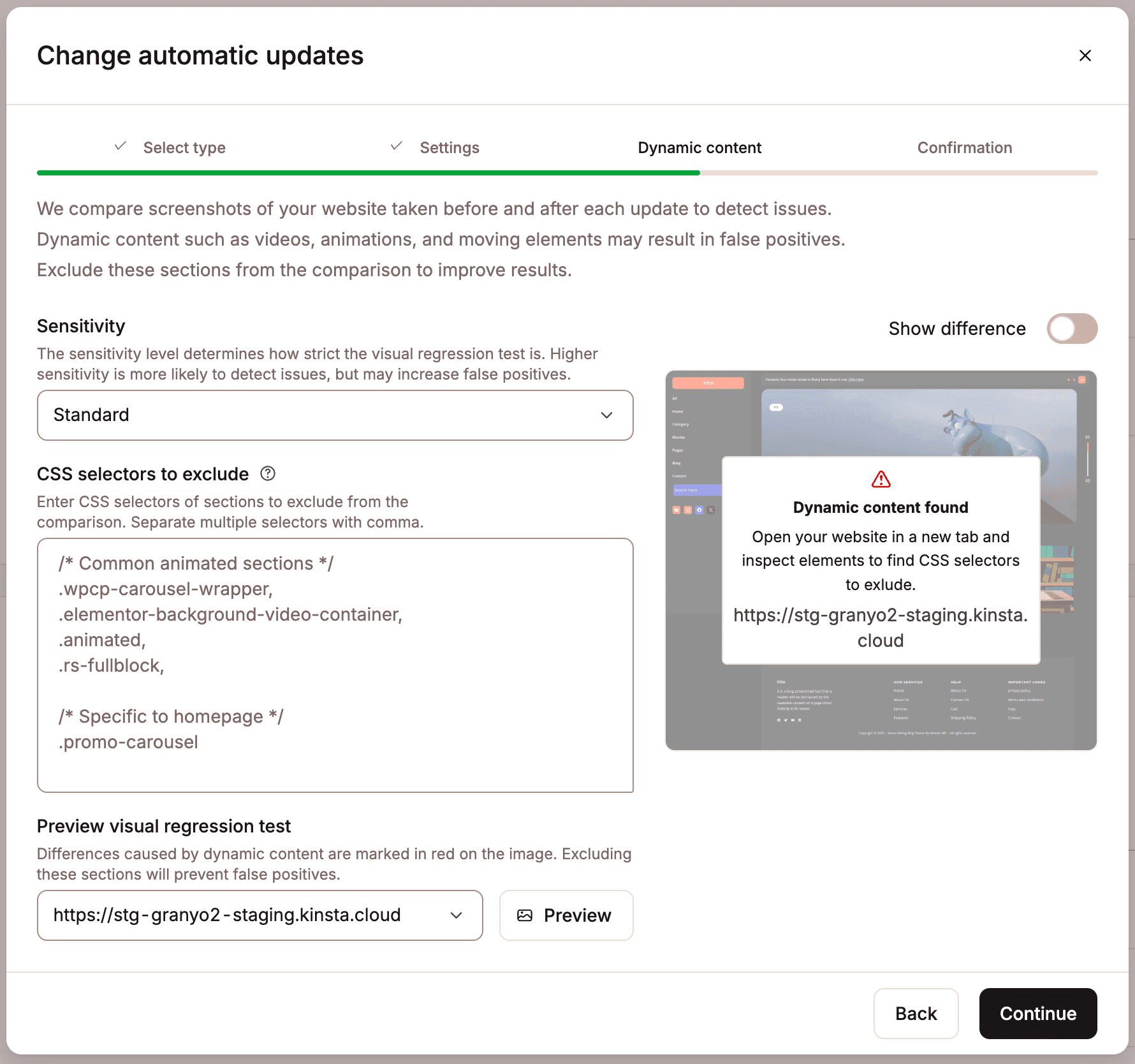
Select Show difference to display a heat map that shows which parts of the page are dynamic as follows:
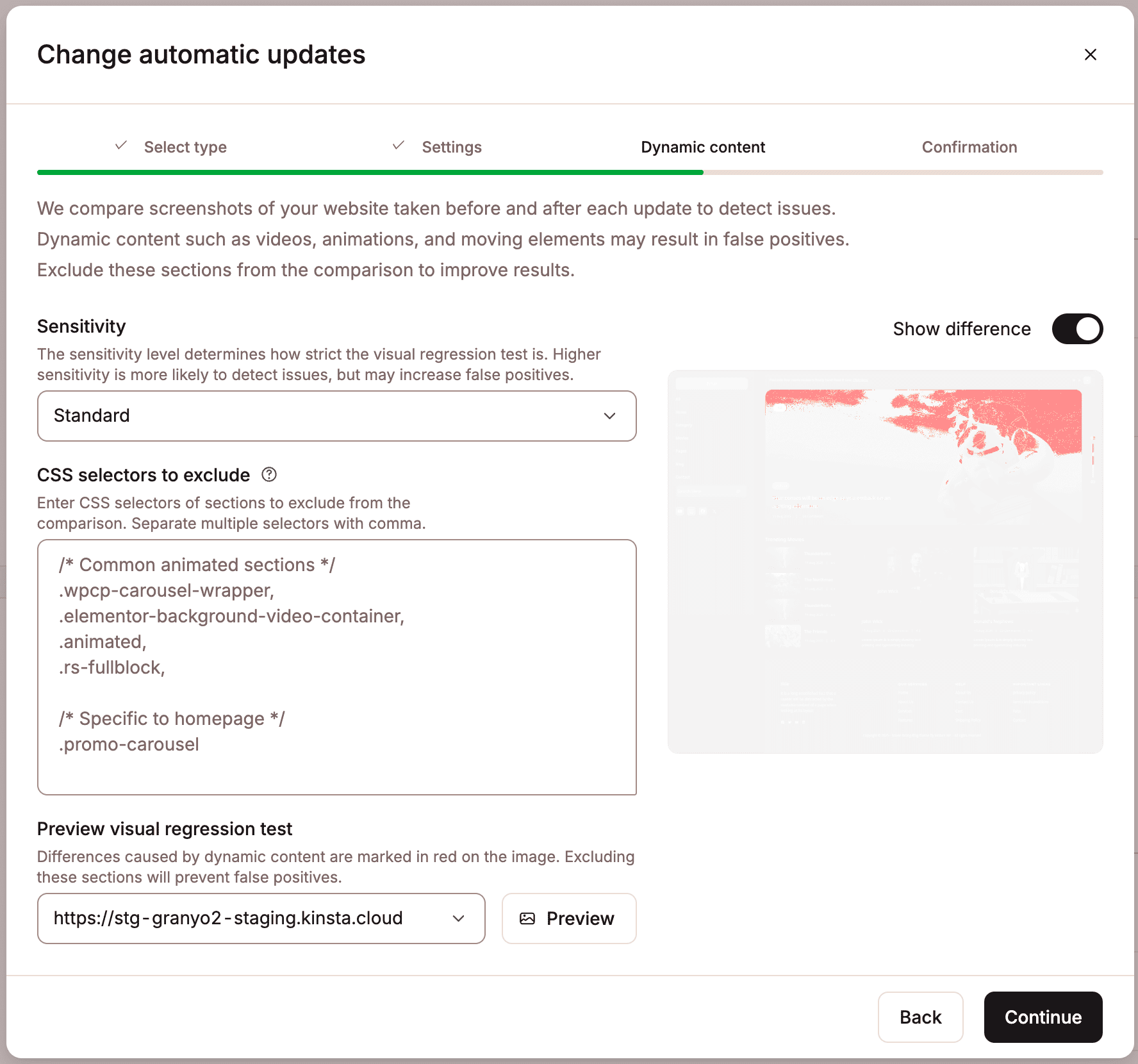
You can then use your browser’s developer tools to inspect that part of the page and locate the CSS selectors for the dynamic content, and you can then add these to the CSS selectors to exclude. For steps on how to do this, refer to How to find a CSS selector. Once you’ve added the selectors, click Preview again to check that all dynamic content has been excluded. If you have excluded all of the dynamic content, a No dynamic content detected message appears, as follows:

You can then click Continue to complete the setup of automatic updates.
Confirmation
The confirmation page shows the price details. To confirm the add-on, click Change automatic updates. The subscription will appear on your next billing cycle and is automatically prorated for your current billing period.
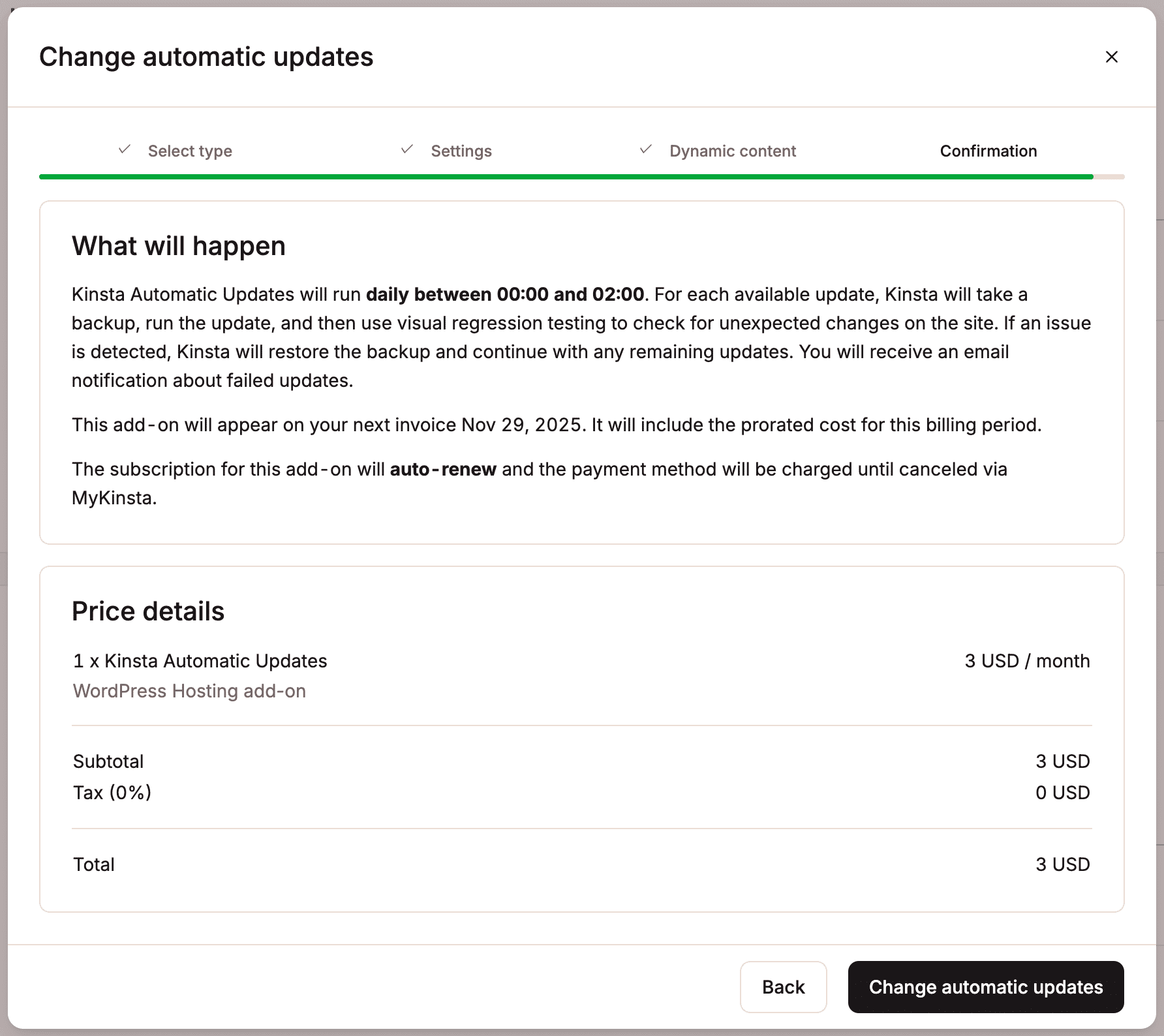
View installed updates
When an update is identified and installed, it appears within Plugins and themes > Kinsta Automatic Updates.

Click Details to view the information about which plugin and theme updates were successful or failed and how many did not have an update or were excluded. For any successful or failed updates, you can click on the plugin or theme name to show:
- The screenshots taken before and after the update. These screenshots are stored for 60 days.
- Any images highlighting differences.
- The error that caused the update to fail.
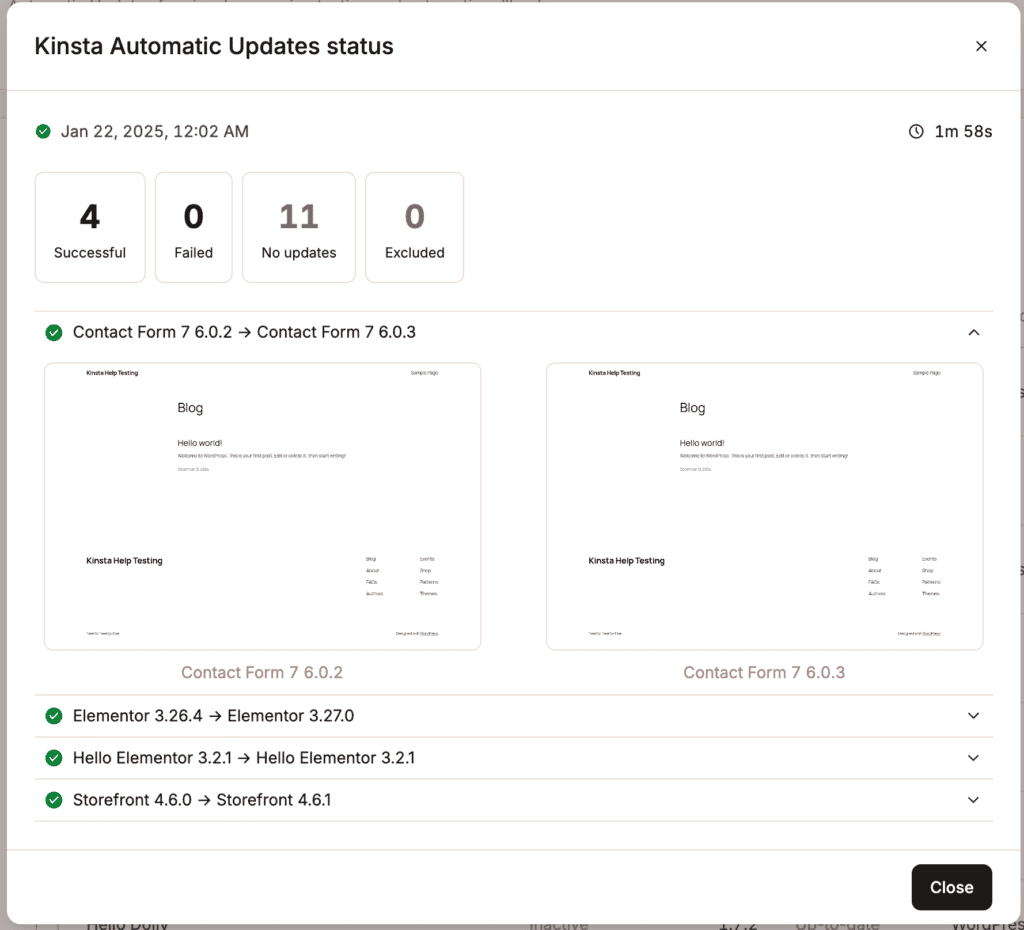
Failed update errors
Domain Error
This error occurs when a domain is unavailable during the update process. In this case, MyKinsta is unable to take or compare screenshots.
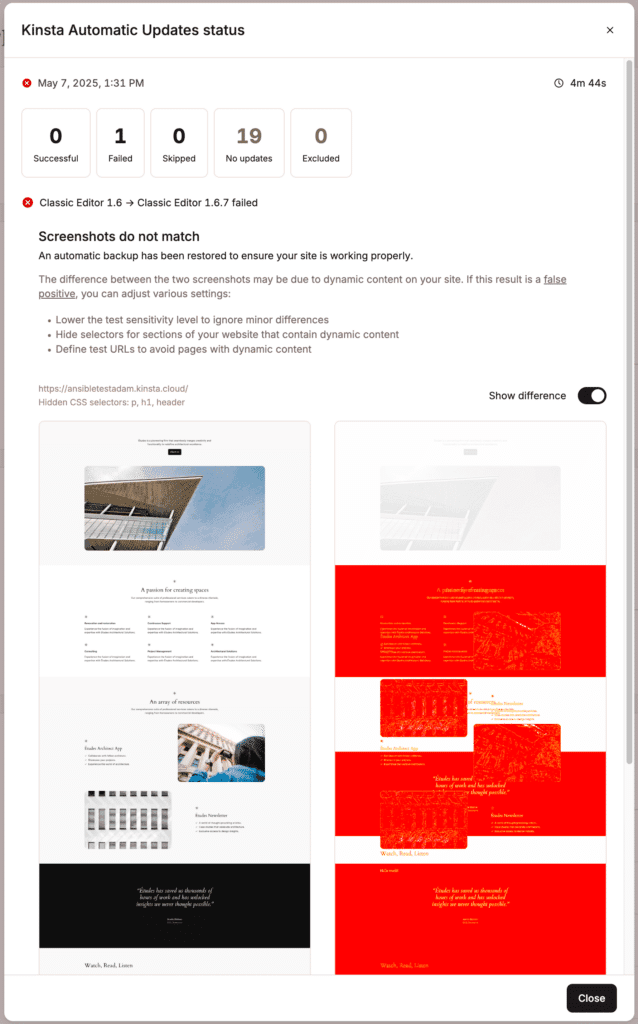
Screenshot Difference
This indicates a minor visual change on the website. The differences are highlighted in the screenshots taken before and after the update. To resolve this, refer to Troubleshooting screenshot differences.

Screenshot Height Difference
This suggests a significant portion of the page is missing or failed to render following an update. The differences are highlighted in the screenshots taken before and after the update. To resolve this, refer to Troubleshooting screenshot differences.
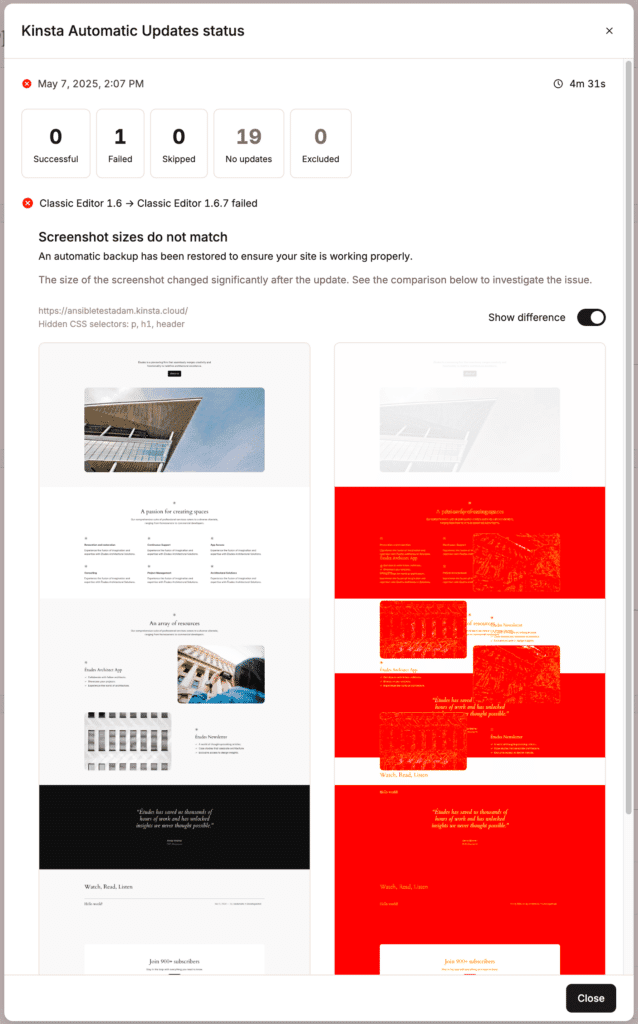
Troubleshooting screenshot differences
Kinsta Automatic Updates includes a visual regression test after each plugin or theme update. This test compares each pixel in two images based on color and brightness, with the sensitivity setting determining the threshold for acceptable differences. It analyzes the homepage and four random pages or specific Test URLs if defined.
- Lower sensitivity ignores minor differences.
- Higher sensitivity detects subtle changes but may increase false positives.
If your site contains dynamic content, videos, or carousels, the test may fail because screenshots taken before and after the update will differ. To prevent this, consider the following:
Hide dynamic CSS selectors
Identify which CSS selectors contain dynamic content and hide these within Hide selectors when you enable automatic updates or within the automatic update settings. To find a CSS selector, use your browser’s inspector. Right-click the content you want to hide, select Inspect, then in the Styles panel, right-click the selector and choose Copy selector.
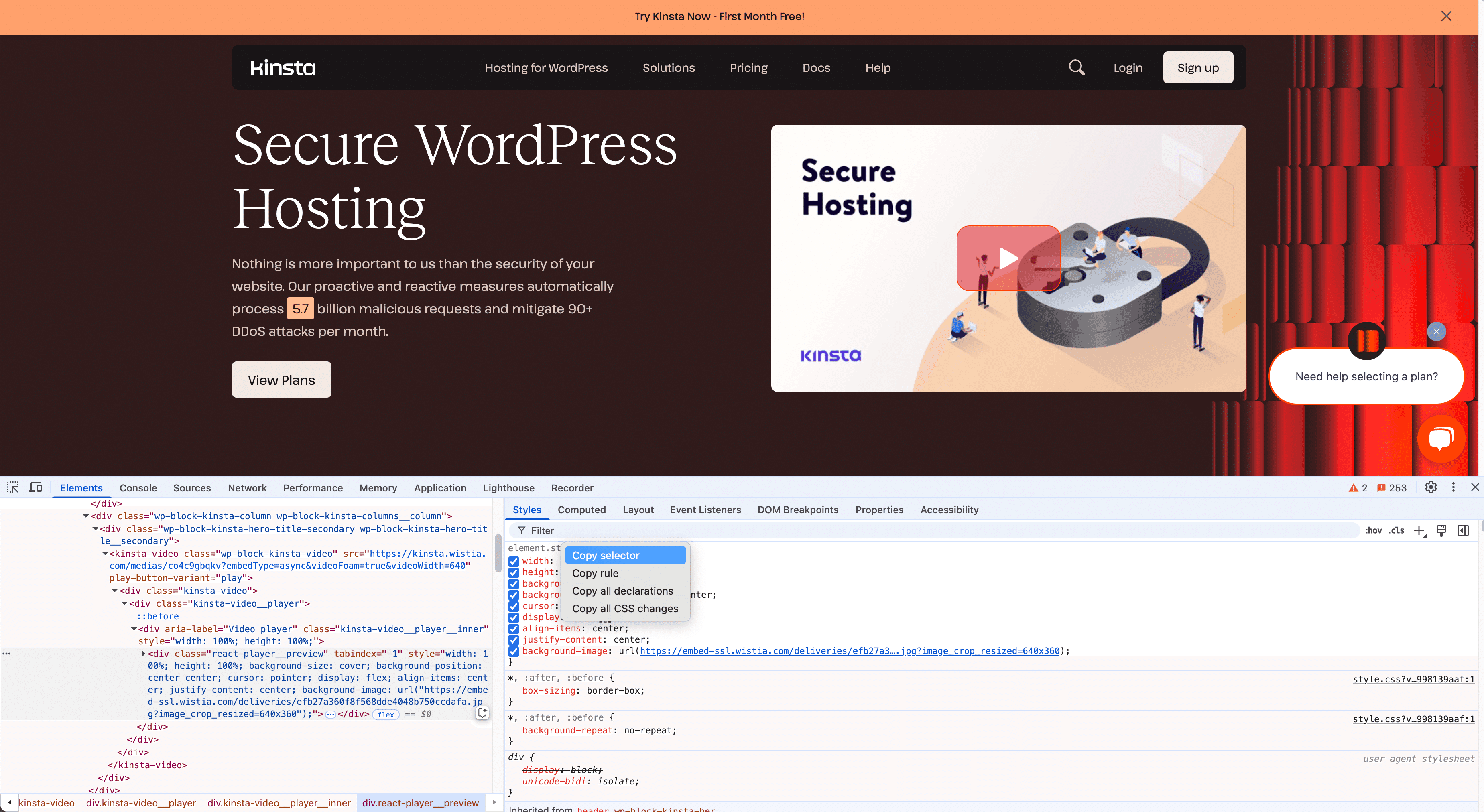
Specify the pages to test
By default, the visual regression test analyzes your homepage and four random URLs from your site. If these pages contain dynamic content, it may lead to more false positives. To reduce this risk, you can specify Test URLs that do not contain dynamic elements when you enable automatic updates or within the automatic update settings.
Adjust the sensitivity level
A higher sensitivity level is more likely to result in false positives as it is more likely to detect even subtle changes. You can lower the sensitivity level so that the test ignores minor differences when you enable automatic updates or within the automatic update settings.
Exclude or change automatic updates for a single plugin or theme
To exclude or change automatic updates for a single plugin or theme, click the kebab (three-dot menu) on that item and click Change automatic updates.
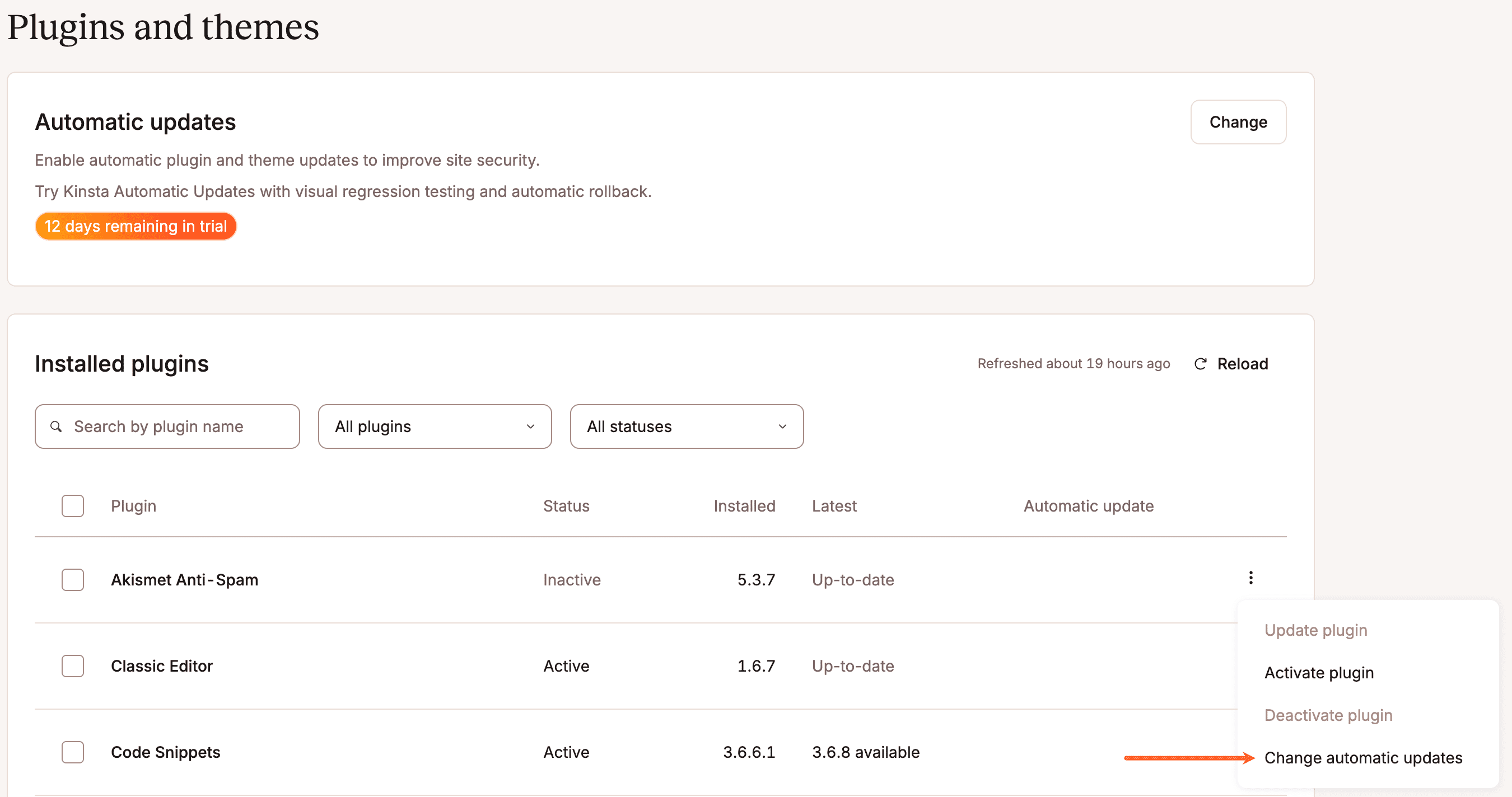
Select the required option and click Change automatic updates.
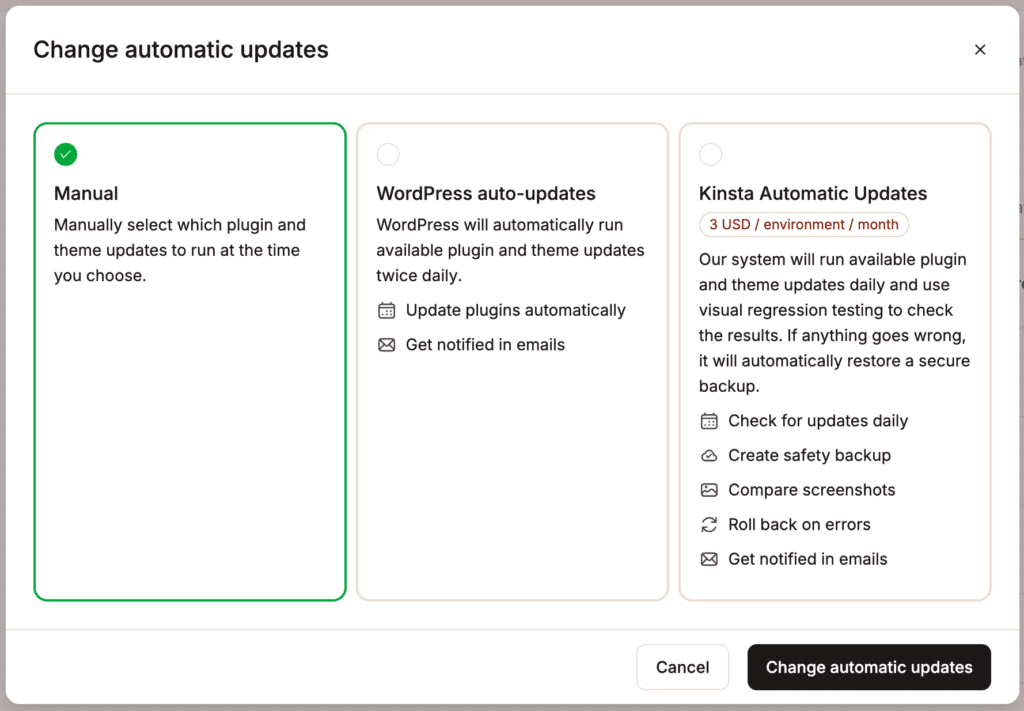
Automatic update notifications
You can set up email notifications for failed or successful updates within your username > User settings > Notifications.

Disable automatic updates
You can disable automatic updates within WordPress sites > sitename > Plugins and themes > Automatic updates > Change. Select Manual and click Change automatic updates.

You can also disable auto-updates for your plugins and themes for multiple sites, including staging sites, simultaneously from the WordPress Sites page. Select the checkboxes next to the sites you want to enable auto-updates for, click Actions, and choose Change automatic updates.

If you have enabled Kinsta Automatic Updates, this removes the add-on. The first month is completely free, so if you cancel within that time, you won’t incur any charges for the add-on. After the free month, if you cancel, you’ll receive a prorated credit for the unused days of the current billing period. This credit will be automatically applied to your account balance and used toward your next Kinsta invoice. For more information, refer to our WordPress Hosting Money-Back Guarantee.
Reverse proxy add-on
When you use a reverse proxy, you can serve multiple sites or applications from a single domain regardless of where they are hosted. Using a reverse proxy also keeps the sites separate so they don’t share the same resources.
Reverse proxies can be complex to install, configure, and support; if your main site and subsite (proxied site) are hosted on Kinsta, you can purchase the Reverse proxy add-on for $50 per month per site, and the Kinsta support team will set up the reverse proxy for you.
To purchase this add-on, click Change on the Add-ons page under Reverse proxy. This opens a modal with the pricing and information about what happens next. To go ahead with the add-on, click Open chat; this opens up a new chat with our Support team, who will set up the add-on for you.
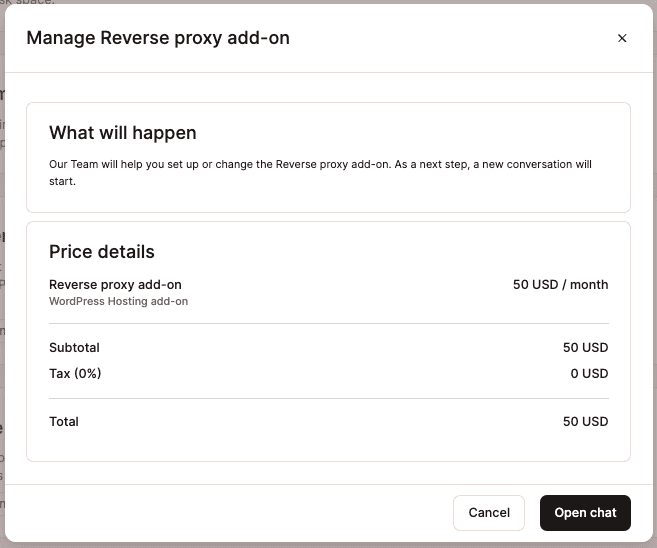
Remove the Reverse proxy add-on
To remove this add-on, within the Add-ons page, under Reverse proxy, click Change > Open chat. This opens up a new chat with our support team, who will remove the add-on for you.
If you remove the reverse proxy add-on and you’re in the first 30 days of your WordPress Hosting plan, a prorated fee for the add-on will be added to your next invoice for the time period it was enabled. If your WordPress Hosting plan has been active for more than 30 days, you will receive a prorated credit for the add-on fees to your Account Balance for the remaining days of the current billing period. The credit is automatically used to offset money owed to Kinsta on your next invoice. For more information, refer to our WordPress Hosting Money-Back Guarantee.
Redis caching add-on
Redis caching stores values generated by WordPress’ native object cache in a persistent manner so that cached objects can be reused between page loads. This can reduce the load on your site’s database, decrease response time, and increase the site’s ability to handle additional traffic. Redis caching is available within MyKinsta as an add-on for your site at $100 per month per site.
To purchase this add-on, click Enable on the Add-ons page under Redis caching. This opens a modal with the pricing and information about what happens next. To proceed with the add-on, click Enable Redis add-on. The add-on will appear on your next invoice.
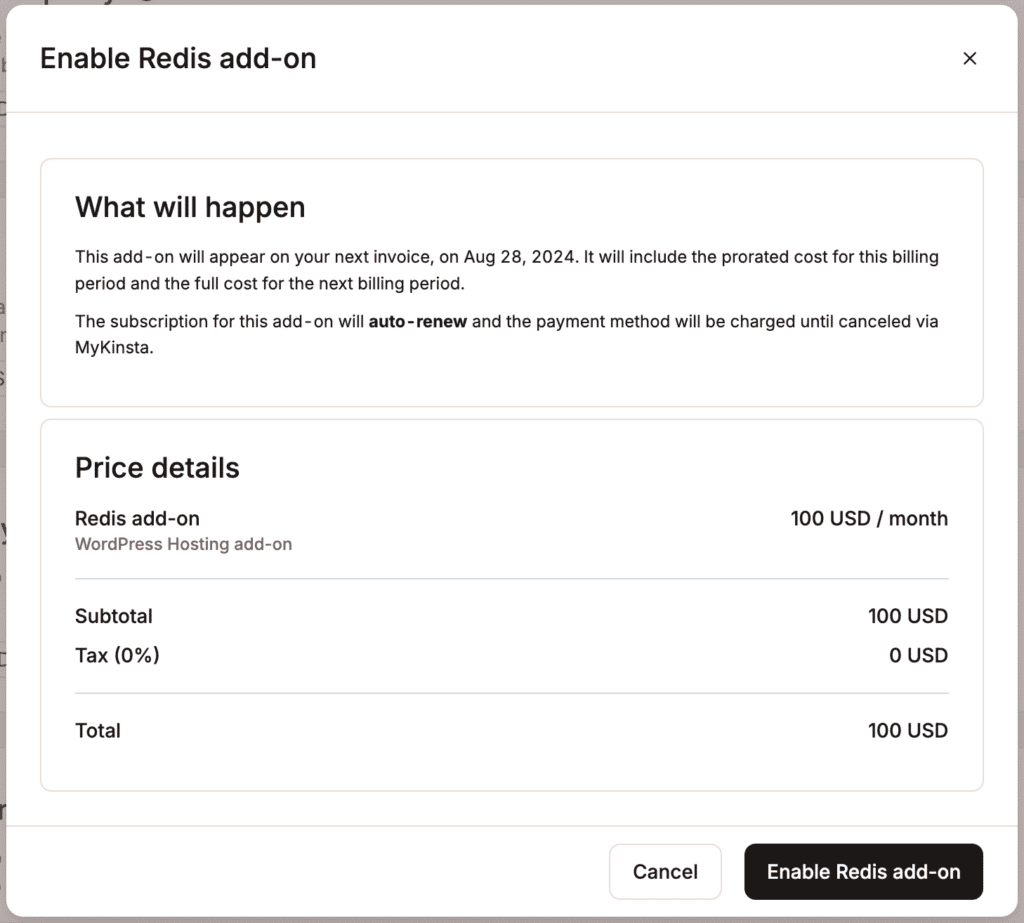
Remove the Redis caching add-on
To remove this add-on, within the Add-ons page, under Redis caching, click Disable > Disable Redis add-on.
If you remove the Redis caching add-on and you’re in the first 30 days of your WordPress Hosting plan, a prorated fee for the add-on will be added to your next invoice for the time period it was enabled. If your WordPress Hosting plan has been active for more than 30 days, you will receive a prorated credit for the add-on fees to your Account Balance for the remaining days of the current billing period. The credit is automatically used to offset money owed to Kinsta on your next invoice. For more information, refer to our WordPress Hosting Money-Back Guarantee.
Hourly backups add-on
If your site changes frequently and you need additional restore points, you can purchase the Hourly backups add-on, which gives you 2 options:
- 6-hour backups at $20 per month per site; a backup is created every 6 hours and is available for 24 hours.
- Hourly backups at $100 per month per site; a backup is created every hour and is available for 24 hours.
To add the Hourly backups add-on, within the Add-ons page, under Hourly backups, click Enable and follow the steps to Enable Hourly Backups.
Change or remove the Hourly backups add-on
You can upgrade or downgrade the frequency of the backups or cancel the add-on within WordPress sites > sitename > Backups > Hourly. To change the frequency, click Change plan, or to cancel the add-on, click Disable.
If you disable the add-on, backups that are currently available will be deleted.
If you remove the hourly backups add-on and you’re in the first 30 days of your WordPress Hosting plan, a prorated fee for the add-on will be added to your next invoice for the time period it was enabled. If your WordPress Hosting plan has been active for more than 30 days, you will receive a prorated credit for the add-on fees to your Account Balance for the remaining days of the current billing period. The credit is automatically used to offset money owed to Kinsta on your next invoice. For more information, refer to our WordPress Hosting Money-Back Guarantee.
External backups add-on
If you want to back up your WordPress site to Google Cloud Storage or Amazon S3, you can purchase the External backups add-on. External backups can be configured for either weekly or monthly frequency, and you can choose between backing up your files, WordPress database, or both. The external backups add-on costs $2 per month per backup plus $1 per GB per month for bandwidth. For example, if you have one site that you back up monthly, that uses 10 GB of external bandwidth, this would cost $12 per month.
To add the External backups add-on, within the Add-ons page, under External backups, click Enable and follow the steps for either External Backups Add-On with Google Cloud Storage or External Backups Add-on With Amazon S3.
Remove the external backups add-on
To remove (and stop) the external backups add-on, go to WordPress Sites > sitename > Backups > External > Disable. To confirm the removal of the external backups add-on, click Remove backups.
This removes access to the backups from MyKinsta; it does not remove the backups from your Google Cloud or Amazon S3 storage.
If you remove the external backups add-on and you’re in the first 30 days of your WordPress Hosting plan, a prorated fee for the add-on will be added to your next invoice for the time period it was enabled. If your WordPress Hosting plan has been active for more than 30 days, you will receive a prorated credit for the add-on fees to your Account Balance for the remaining days of the current billing period. The credit is automatically used to offset money owed to Kinsta on your next invoice. For more information, refer to our WordPress Hosting Money-Back Guarantee.
WordPress site add-on
The WordPress site add-on allows you to increase the number of sites in your plan without upgrading the plan. Each additional site includes a staging environment and is charged at $30 per month. The add-on does not include additional disk space. Resources like visits, disk space, and CDN usage are shared across all sites within the plan. For example, with a WP 2 visits plan, if you purchase the add-on for an additional site, the 70,000 visits, 20GB of disk space, and 250GB of CDN usage will be distributed among all three sites.
This is available within your username > Company settings > My Plan > WordPress sites. When you upgrade or change your plan, any site add-ons you have will be retained, even if the new plan includes more sites by default. For example, if you’re on the Single 35k visits plan with a site add-on and you upgrade to the WP 2 plan, which includes two sites, the site add-on will still apply, giving you a total of three sites. If you no longer require the site add-on, you must disable it.
Add sites
To add a site, within MyKinsta, click your username > Company settings > My Plan, and within WordPress sites, click Enable.
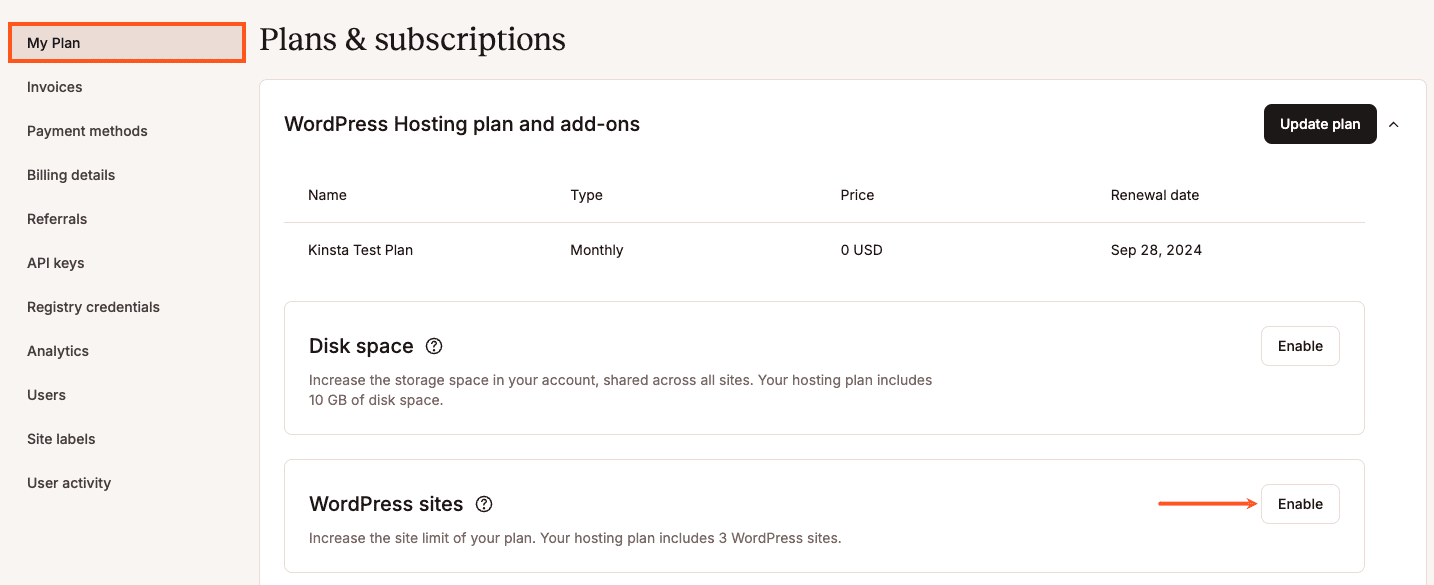
Enter the number of additional WordPress sites you want to add, and click Continue.
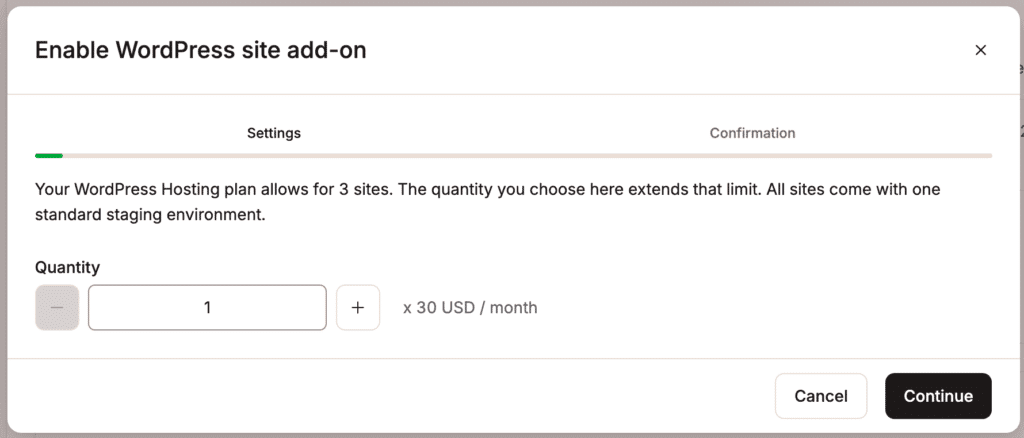
Review the price details and click Enable WordPress site add-on.
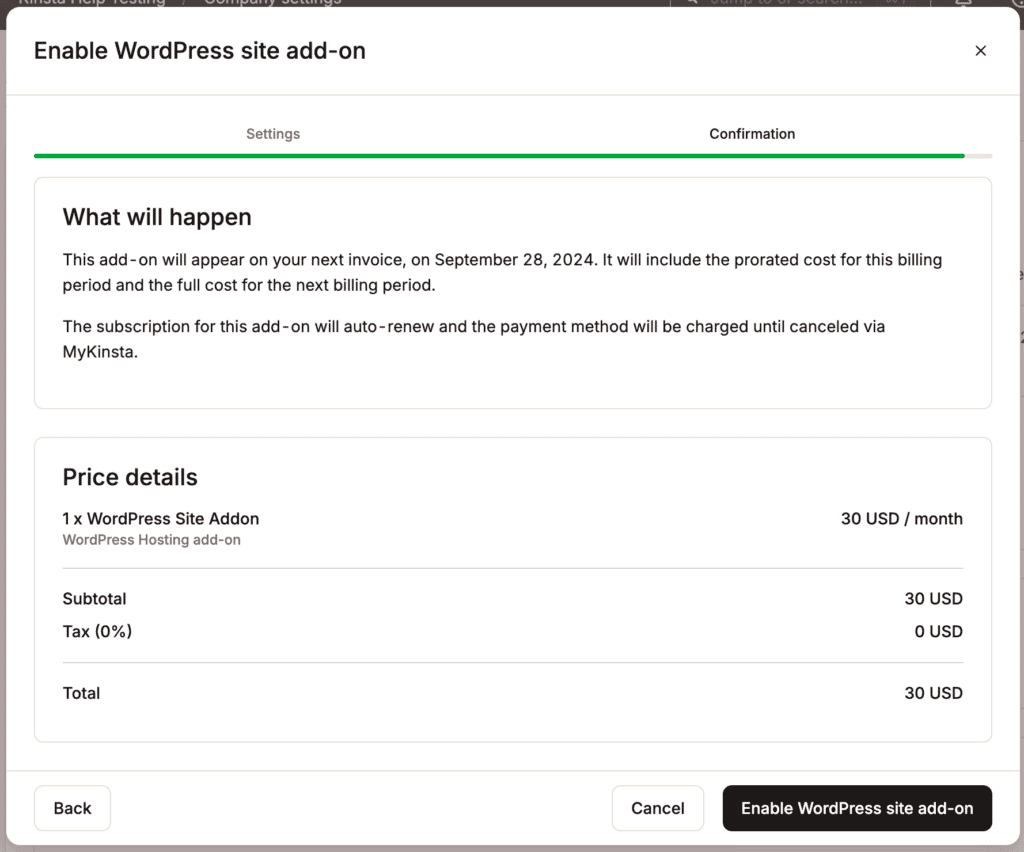
WordPress site add-ons are automatically prorated, and the subscription will appear on your next billing cycle.
Change the number of sites
If you want to reduce the number of sites within the WordPress site add-on, you must first delete the sites you no longer need within WordPress Sites > sitename > Info > Delete site. Deleting a site removes all sites, databases, and staging environments for that site.
To change the WordPress site add-on, within MyKinsta, click your username > Company settings > My Plan, and within WordPress sites, click Change.
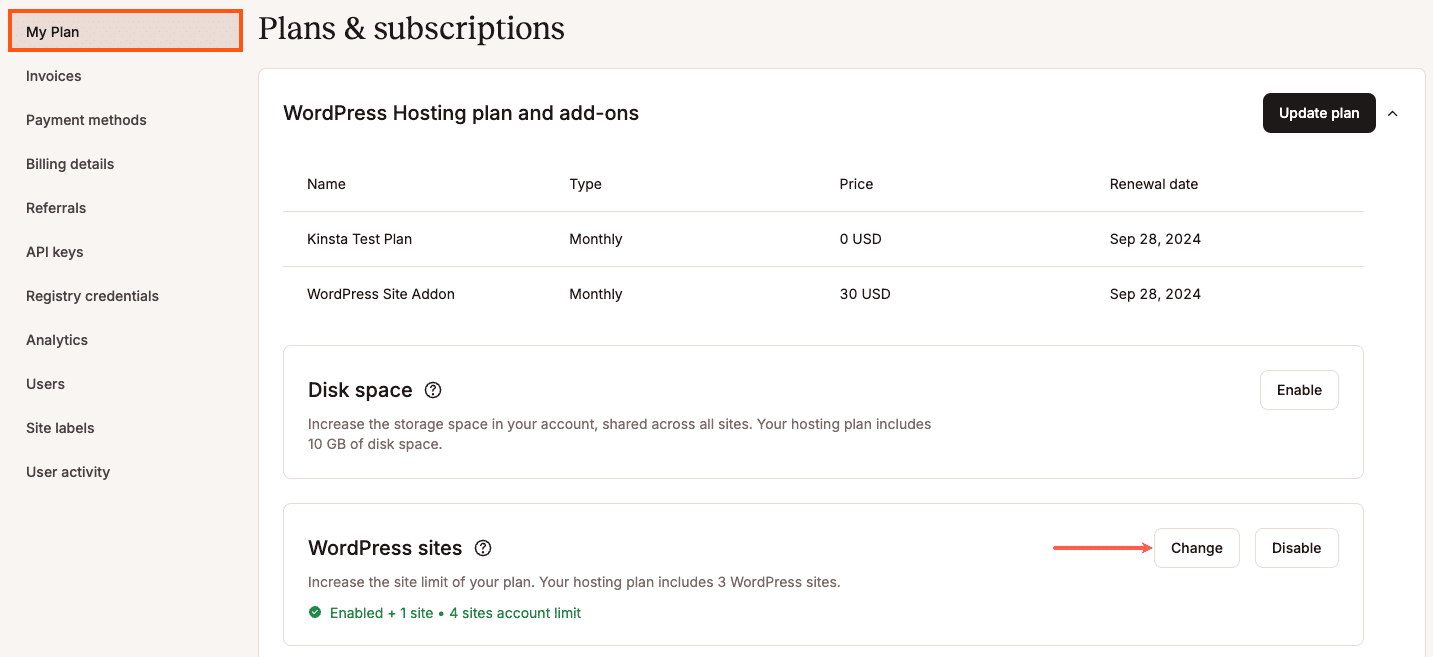
Increase or decrease the quantity and click Continue.
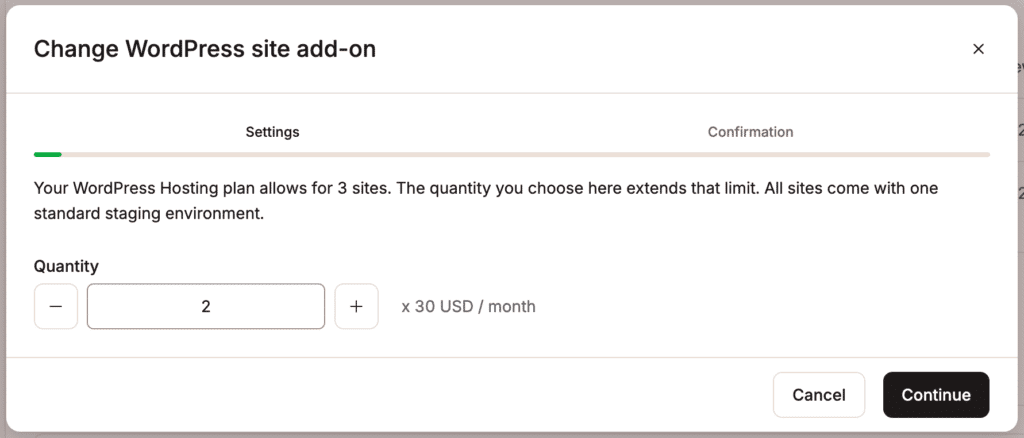
If you increase or decrease the number of sites, the new price details are shown. If you change the quantity to zero, the add-on is disabled. To confirm the changes, click Change WordPress site add-on.
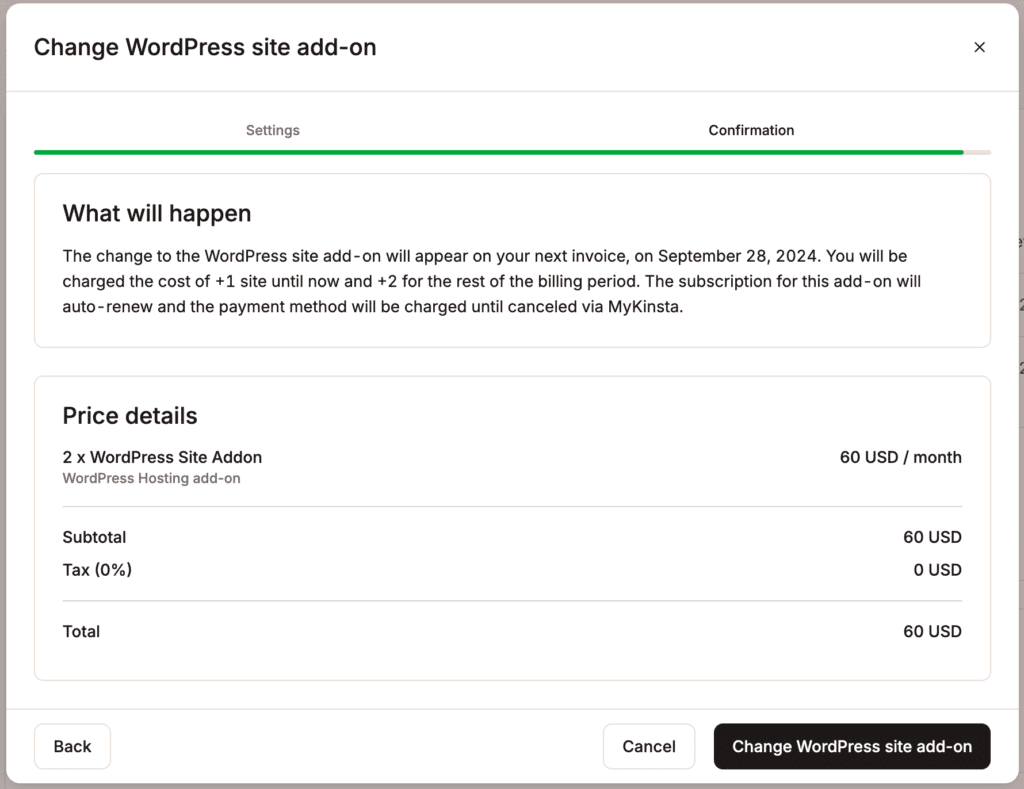
If you reduce the number of sites or change the quantity to zero, and you’re in the first 30 days of your WordPress Hosting plan, a prorated fee for the add-on will be added to your next invoice for the time period it was enabled. If your WordPress Hosting plan has been active for more than 30 days, you will receive a prorated credit for the add-on fees to your Account Balance for the remaining days of the current billing period. The credit is automatically used to offset money owed to Kinsta on your next invoice. For more information, refer to our WordPress Hosting Money-Back Guarantee.
Disable the WordPress site add-on
If you want to disable the WordPress site add-on, you must first delete the sites you no longer need within WordPress Sites > sitename > Info > Delete site. Deleting a site removes all sites, databases, and staging environments for that site.
To disable the WordPress site add-on, within MyKinsta, click your username > Company settings > My Plan, and within WordPress sites, click Disable.
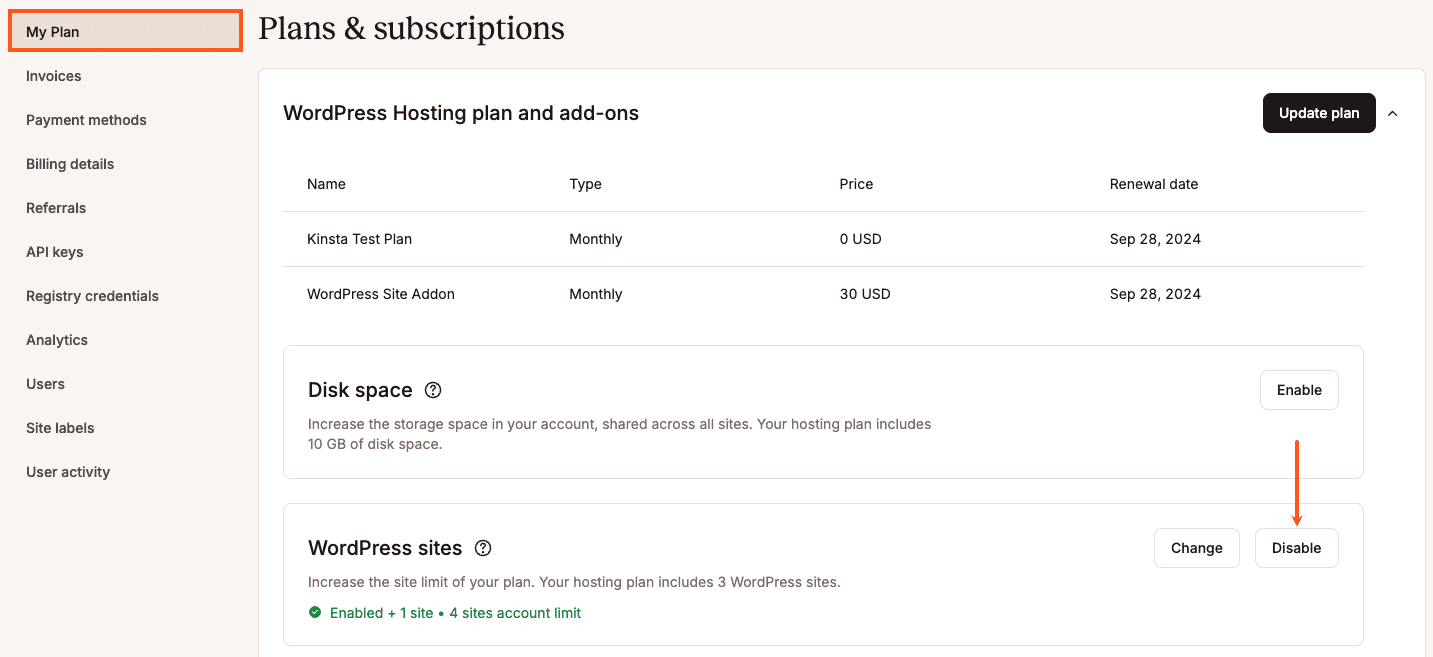
To confirm you want to disable the add-on, click Disable.

If you disable the WordPress site add-on and you’re in the first 30 days of your WordPress Hosting plan, a prorated fee for the add-on will be added to your next invoice for the time period it was enabled. If your WordPress Hosting plan has been active for more than 30 days, you will receive a prorated credit for the add-on fees to your Account Balance for the remaining days of the current billing period. The credit is automatically used to offset money owed to Kinsta on your next invoice. For more information, refer to our WordPress Hosting Money-Back Guarantee.